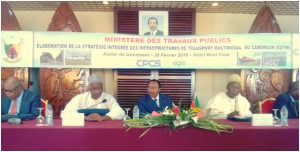By DOH JAMES SONKEY
In a move to diversify its means of public transport, the government has launched the elaboration of an integrated strategy for multimodal transport in Cameroon.
Launching the project last February 28, 2018 at the Yaounde Mont Febe Hotel, Public Works Minister, Emmanuel Nganou Djoumessi said the study is aimed at facilitating economic growth and to support sustainable development in Cameroon through a harmonious and coordinated development of investments in the transport domain in respect to objectives defined in Vision 2035 and the Strategic Paper for Growth and Employment.

In a chat with reporters, Minister Emmanuel Nganou Djoumessi explained that the study under elaboration will enable Cameroon to have a coherent tool of assistance in programming and planning of investments in the transport sector in general and that of infrastructure in particular in other to facilitate cohabitation of the three modes of transport such as the road, railway and airway. Cameroon wants to develop these other means of transport so that the load on road transport can be reduced in order to prevent it from deteriorating.
The Public Works boss added that through this project, government wants to promote the movement of persons and goods in a more fluid and less strenuous manner.
On his part, World Bank’s Programme Leader Sustainable Development, Issa Diaw who represented the country Director of the Bretons Wood Institution at the ceremony, explained that the study will, in addition to other advantages, help Cameroon ameliorate, in the long run, its competence in sustainable development and transport management.
By the end of the study in 26 months time, it is expected that Cameroon will be equipped with a multimodal strategy of transport infrastructures that will contain the following elements; a long term vision of the sector, strategic objectives and results to be attained in short, mid and long terms, sectorial policies, intra-modal and intermodal to be put in place to guide the execution of the defined strategies and programmes, legal, institutional and regulation changes and strategies necessary to attain investment objective and the creation of management capacity of the sector etc.